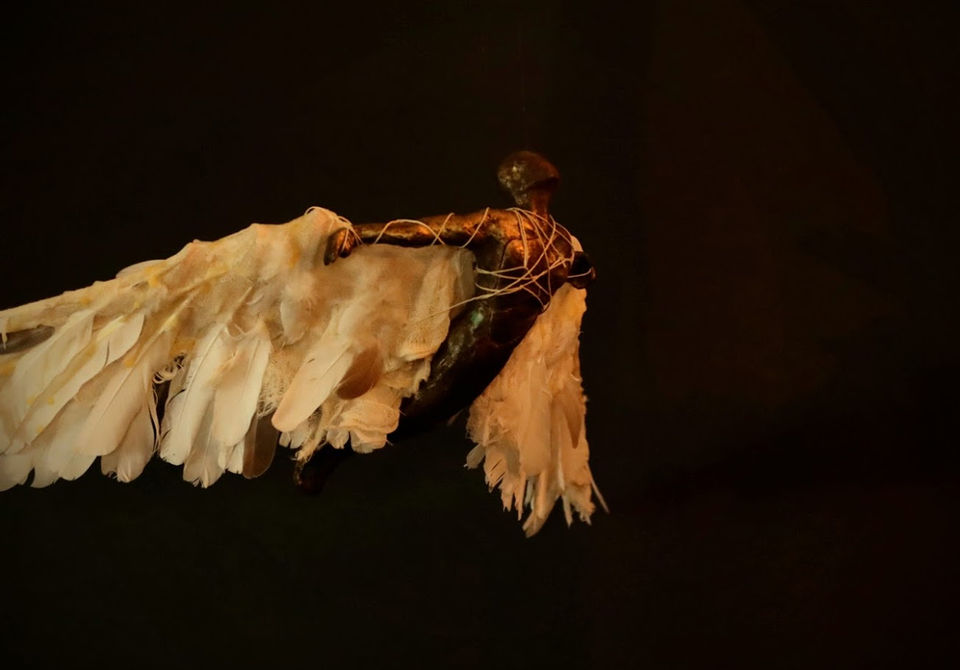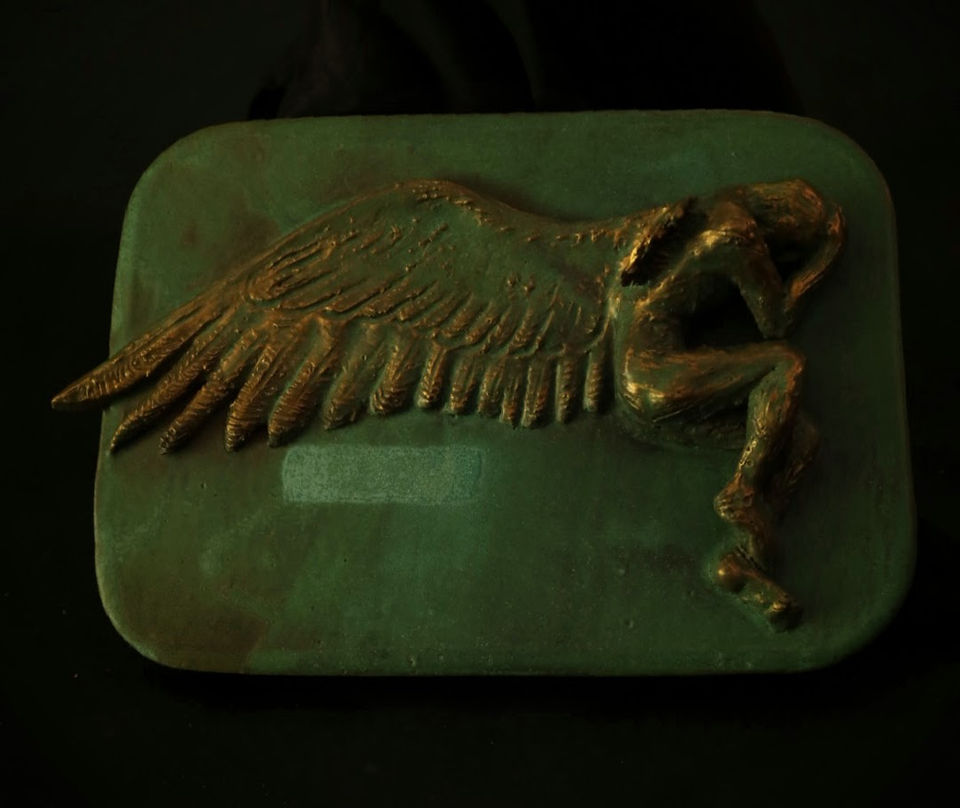

Art by
H. Highwater

3d Juried Award winner at ArtPrize!
"'Old Stories' is a series of intimate, individual, (mainly) ceramic works that collectively relate a tale of the human experience. Exhibiting an adept use of medium, the handbuilt clay pieces expertly covered in matte glazes give the appearance of age-weathered patinas, while utilizing light, liquid, movement, and ornamentation to encourage the viewer into a closer, prolonged look at each sculpture. The small-scale structures, firmly rooted and weighty, are delicately accented by waxed, feather-winged figures hovering above the greenery that lines the archway entry. The chapters of this story unfold like a participatory installation of Ancient Greek mythology, whose concepts are eerily relevant in today's world. Themes of fear, isolation, and exhaustion are present, but these feelings are matched by the beauty in which Highwater exhibits a mastery of materials and storytelling. Ultimately, the work is uplifting and light, giving us hope in a world that often feels dark."
About
H. Highwater is a multimedia artist, primarily focused on evocative, figurative expression. Her current body of work revolves around mythology, outcasts, and the tragic inevitability of a story that has already ended. Her sculptures challenge the roles of hero and monster in ages-old stories, and often spark feelings of melancholy, empathy, and a curious grief.
Highwater's sculptural pieces consist mainly of ceramic, with added media including wood, fabric, naturally harvested feathers, and stone. She works mainly out of her Michigan home and in a shared studio space, where she benefits from a collaborative environment with fellow artists and craftspeople. When not working on sculptural pieces, she also paints, does bookmaking, and enjoys reading, playing with her cats and foster kittens, board games/tabletop RPGs, and gardening.
To inquire about purchasing sculptures, exhibiting work, or commissions, please get in touch through the "Contact" page.

Asterion
In certain iterations of the myth of the minotaur, the minotaur was called Asterion, "Starry One."
But had he ever even seen the stars? Could he remember what they looked like?
"Asterion" is about nostalgia, childhood, and the reminder that every monster was innocent once.
Ceramic, 2024.
Sold. $1,125.00
A crack in the Labyrinth
The minotaur was considered a monster, but was not killed--instead, it was trapped inside a labyrinth which it could not escape. The myths do not speak to how, or if, it ever tried to get out.
"A Crack in the Labyrinth" evokes feelings of melancholy, enclosure, of desperation, and exhaustion, but simultaneously, a feeling of acceptance.
Ceramic, 2024.
Available for purchase, but cannot be shipped until after exhibition at the Garret Museum of Art from October 10, 2025 – December 21, 2025.
$1,500
The Stars, At Last
The myth of the minotaur ends when the hero Theseus enters the labyrinth, aided by Ariadne, half-sister of Asterion, who provided Theseus with a ball of string to guide him through the maze. Theseus defeats the minotaur, and leaves, triumphant.
"The Stars, At Last" contemplates the traditional end to the myth, but simultaneously offers an alternative: maybe the minotaur left the labyrinth, too. The viewer decides if this is a literal escape, or the minotaur finding a form of freedom in death. This sculpture challenges the idea that the original ending of this myth is truly a tale of heroism, or a tragedy. Nonetheless, hope remains at the end.
At the center of the labyrinth, Asterion remains a child, and the story begins again.
Ceramic, 2024.
$2,200 - Please be advised that shipping on this piece is perilous, and may require special negotiation depending on purchaser's destination.
Icarus: The Sun
Icarus, escaping from the place where he was trapped, soars skywards. His father Daedalus, the architect of the Labyrinth, who built their wings to escape from their imprisonment, warned him that if he flew too high, the heat of the sunlight would melt the wax from his wings, and if he flew too low, the weight of sea spray would soak his wings and drag him down. Caught in the euphoria of first flight and the joy of freedom, Icarus climbs higher and higher towards the sun. The wax holding his feathers begins to melt away…
Ceramic, mixed media, 2024.
$1,200
Icarus: The Sky
Icarus, did you step from the stone into the sky and swear to yourself
to never touch the cold earth again
Did the world fall away under your wings
(feathers from the little birds that perched in the rafters of the maze your father built,
wax from candles in the dim hallways,
rope from when they dragged the beast into the Labyrinth, left behind after it died)
and did you gaze only up into the expanse,
the white sky, the gold sun, the promise of open air
Did you hesitate at all?
Did you remember the warnings and know you could never outrun a king forever,
and make the choice anyways—
Icarus, the sun, the sky, the sea below—
Did you feel the burn of your shoulders as you flew,
and pressed onwards, upwards,
Icarus, did you never look down,
not for a moment
Did you feel the wind roaring, the heat of wax melting,
and forget the damp dark quiet of the Labyrinth at last
Icarus, did the world fall away, and did you fall in love at the end,
with the sun and the sky and the sea and the freedom of falling--
Ceramic, mixed media, 2024.
Sold. $1,200
Icarus: The Sea
Icarus, tell us it wasn’t an accident,
Tell us you loved it
And you would never have turned back.
Ceramic, mixed media, 2024.
Sold. $1,400.00
Old Stories
These stories were first told thousands of years ago, thousands of miles away. First, they passed only through oral tradition; then plays were performed and written down; songs and epics composed; and then books, first hand-written, later printed by machine. And for every year since their first telling, these stories have been kept alive, told again and again, changing a little with every person who recites them. Something in these old stories still resonates with us; some common thread of humanity among gods and monsters.
This 1884 children’s mythology schoolbook contains short versions of the myths in this series, marked with brass pins.
Ceramic, paper, lamp, 2024.
$400
The Two-Headed Calf
A tribute to the poem by Laura Gilpin, and all the lives too fragile to last.
Tomorrow when the farm boys find this
freak of nature, they will wrap his body
in newspaper and carry him to the museum.
But tonight he is alive and in the north
field with his mother. It is a perfect
summer evening: the moon rising over
the orchard, the wind in the grass.
And as he stares into the sky, there
are twice as many stars as usual.
-Laura Gilpin, "The Two-headed Calf" from The Hocus Pocus of the Universe.
Ceramic, glass.
$1,200
Persephone & Hades
Persephone throws her head back, her palm filled with garnet pomegranate arils--this moment is the turning point of her story, and of Hades's. In her other hand, a glittering fruit. Hades kneels in front of her, enraptured; not clasping her hands or forcing her to act. This is, decisively, Persephone's choice.
Ceramic, garnets, 2025.
You can see this piece on exhibition at the Garret Museum of Art from October 10, 2025 – December 21, 2025.
Sold. $1,200.
Prometheus
Prometheus, known in mythology for bringing the first fire to warm humankind, was punished for doing so, chained to rock and tormented by an eagle. This sculpture sits in contemplation of the flame.
Prometheus is a working oil lamp, with a small container for oil hidden inside the base, and a cotton wick drawing fuel into his palm.
Ceramic, mixed media, 2024.
Sold. $1,150.00
Orpheus and Eurydice
Two figures stand at the threshold of life and death. If Orpheus can complete the journey without looking back to see if Eurydice is following him, his lost love will return to life with him. A moment before success, Orpheus turns back to Eurydice.
Ceramic, 2024.
Sold. $900
Narcissus
Narcissus was born handsome and wanted by everyone. He rejected all advances, fleeing those who pursued him. For spurning his suitors, he was cursed: to be doomed the moment he knew himself; to love only that which would not love him back. And so it was: Narcissus saw his own reflection for the first time in a pool of still water, and was entranced. Trapped by his reflection, he gazed into the water until he wasted away, leaving nothing behind but a golden flower.
In a mythos full of capricious gods, ravaging heroes, and half-human monsters, Narcissus’ only crime was being beautiful and solitary. Did he find a stranger in his reflection? Or was it himself he could not love? Narcissus, we hope the water was fathomless; we hope you found something worthwhile in yourself.
Ceramic, mixed media, 2024.
Sold. $1,150.00
See this piece on exhibition at the Garret Museum of Art from October 10, 2025 – December 21, 2025.
Sisyphus
Turning away for just a moment from his eternity of labor, Sisyphus gazes out at the world; his back braces the boulder just shy of the peak, but he is relaxed. For just a second, Sisyphus is at rest.
Ceramic, 2024.
Sold. $1,400
Here's To All The Burnouts
Tilted askew on a bowl upset by the force of impact, this figure stares down at the fire in his chest. Oil draws from a hidden inner wall of the bowl; bowl is food-safe.
Ceramic, oil lamp, 2024.
Sold. $1,400
Lightbringer
Lightbringer is a working oil lamp, with a small container for oil hidden inside the base, and a cotton wick drawing fuel into his palm.
Ceramic, mixed media, 2024.
Sold. $1,075





















































































